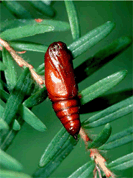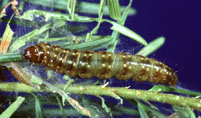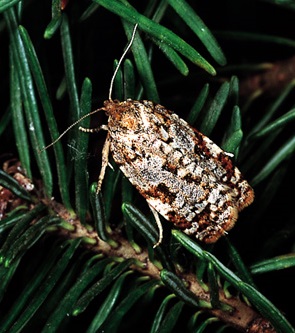Western spruce budworm
Choristoneura occidentalis
The western spruce budworm is an important native defoliator of interior Douglas-fir. Population levels periodically reach outbreaks which can last up to 25 years .
On this page
Description
The western spruce budworm requires one year to complete its life cycle. Certain factors contribute to a stand's susceptibility to outbreaks.
Budworm moths mate and lay eggs in late July through to August. The eggs are laid in masses (up to 150) on the underside of needles, overlapping like fish scales. They are bright green when laid, measuring slightly less than 1cm in total length, and become translucent when empty. The eggs hatch within 12 days.
The larva pupates from late June to mid July. The reddish brown pupa is 12 to 16mm long, being broad at the head end, tapering to a point at the rear. The pupal stage lasts on average two weeks.
A peak outbreak of western spruce budworm in 1987 affected 800,000 ha of forest. The majority of infestation was located in the southern interior of British Columbia.
Host tree species
The primary host of this budworm is interior Douglas-fir. Other tree species such as the true firs (for example subalpine fir), western larch and, to a lesser degree, spruce can also be affected.
Damage symptoms
The larval stage defoliates host trees and causes visible damage and tree mortality. When trees are stressed they are more likely to die.
Repeated budworm defoliation causes tree mortality over large areas, reduction of growth rates and reduced lumber quality. Sustained attack results in complete defoliation in four to five years.
Once an infestation has subsided, surviving trees take several years to regain full foliage and resume growth. Successive years of defoliation in stands may predispose trees to other insects and pathogens such as bark beetles and root disease.
Identification images

Pupa

Larvae

Adult
Further reading
Read more about the western spruce budworm in the Field Guide to Forest Damage in B.C. (PDF, 6.6MB)
